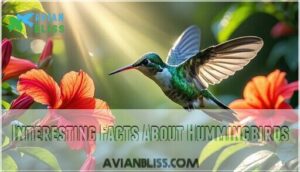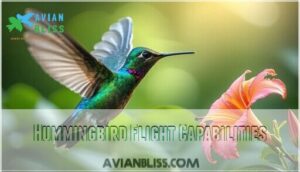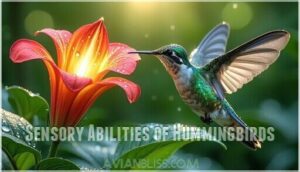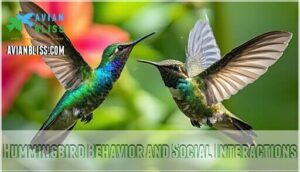This site is supported by our readers. We may earn a commission, at no cost to you, if you purchase through links.

These birds, found only in the Americas, boast over 340 species, with the smallest being just 2 inches long.
Their wings beat so fast—up to 5,400 times a minute—that they can hover mid-air or even fly backward.
Despite weighing less than a penny, they migrate immense distances; some species cover 3,000 miles annually.
Powered by nectar, they’re energy machines, visiting hundreds of flowers daily.
Fun fact: their hearts can beat over 1,200 times per minute, which makes them truly extraordinary creatures.
Curious about their unique abilities? Stick around to uncover what makes these little marvels so extraordinary.
Table Of Contents
- Hummingbird Diversity and Geography
- Interesting Facts About Hummingbirds
- Hummingbird Flight Capabilities
- Hummingbird Migration Patterns
- Unique Physical Characteristics of Hummingbirds
- Hummingbird Reproduction and Nesting Habits
- Hummingbird Diet and Nutritional Needs
- Sensory Abilities of Hummingbirds
- Hummingbird Behavior and Social Interactions
- Special Adaptations of Hummingbirds
- Frequently Asked Questions (FAQs)
- What is unique about hummingbirds?
- What is the unique ability of the hummingbird?
- What is an unusual hummingbird behavior?
- What are some fun facts about hummingbirds for kids?
- What are some interesting facts about hummingbirds?
- Do hummingbirds Hum?
- Where do hummingbirds come from?
- How big do hummingbirds get?
- Are hummingbirds fast?
- Are hummingbirds diurnal?
- Conclusion
Hummingbird Diversity and Geography
You’ll find over 360 species of hummingbirds spread across the Americas, with Ecuador alone hosting more than 130 different types.
While most hummingbirds live in tropical regions like the northern Andes where diversity peaks, only a few species regularly visit the United States, such as the common Ruby-throated Hummingbird.
Highest Hummingbird Diversity Location
In Ecuador’s Andes Region, a hummingbird hotspot boasts over 130 species.
These tiny birds can travel incredible distances during migration.
Tropical zones support high species diversity. Andes Region is a biodiversity center.
Ecuador Species are diverse. Hummingbird diversity is prominent, and this region is known for its high species diversity.
Range of Hummingbirds in The Americas
You’ll find hummingbirds across the western hemisphere.
Here are key locations:
- North America
- Central America
- South America
- The northern Andes, showcasing their species distribution and habitat range, influenced by geographic factors and altitudinal limits, which is a key aspect of their habitat range.
US Hummingbird Species
In the US, you’ll spot 15 hummingbird species, including Ruby-throated and Rufous hummingbirds, during their migration.
Each species offers unique identification tips for birdwatchers, making backyard feeders a stage for nature’s display, with regional varieties like the Broad-tailed Hummingbird showcasing hummingbird conservation efforts.
Interesting Facts About Hummingbirds
You’re about to uncover some fascinating secrets about hummingbirds.
These tiny birds are full of surprises. With their rapid wing beats, they can fly backwards and even upside down.
Hummingbirds defy gravity, effortlessly flying backward and even upside down with astonishing agility and grace.
Their long, extendable tongues, like a built-in straw, help them drink nectar from flowers. Hummingbirds play a key role in pollination, transferring pollen between flowers.
Their bright feather colors and unique beak shape make them a wonder to behold. As you learn more about these avian wonders, you’ll discover 10 interesting facts about hummingbirds, including their energy storage methods and fun facts about their behavior.
One interesting hummingbird fact is their ability to remember feeder locations, showcasing their impressive memory.
Hummingbird Flight Capabilities
You’re about to discover the amazing flight capabilities of hummingbirds, which will leave you in awe.
Hummingbirds defy gravity with dazzling flight tricks, hovering effortlessly and zooming backward in ways no other bird can match.
As you explore their flight patterns, you’ll learn about their incredible speed, rapid wing flap rate, and impressive agility, which enable them to fly backwards, upside down, and even hover in mid-air.
Speed of Hummingbirds in Flight
You’ll be amazed by hummingbirds’ flight speed, reaching up to 50 mph, thanks to their specialized wing design and aerodynamic lift, allowing them to dart between blooms with precision, overcoming air resistance with their rapid wing beats.
Their high metabolism requires them to eat constantly, related to their high energy needs to fuel their activities and support their overall high energy lifestyle.
Wing Flap Rate of Hummingbirds
You’ll notice hummingbirds flap their wings about 80 times per second, creating rapid wingbeats that drive their unique flight patterns and hummingbird speed.
With each wingbeat overcoming air resistance through precise feather movement and beat frequency of their hummingbird wings.
Agility and Maneuverability of Hummingbirds
You’ll marvel at hummingbirds’ agility and maneuverability, showcasing incredible aerial acrobatics with precise hovering and backward flight, thanks to unique adaptations.
These adaptations include:
- 360-degree turns
- Quick dives
- Instant direction changes
- Effortless hovering
- Fly backward with hummingbird wings and speed.
Hummingbird Migration Patterns
You’re about to discover the amazing migration patterns of hummingbirds, which take them thousands of miles each year.
As you learn about their journeys, you’ll find out what triggers their migrations and which species travel the farthest distances, like the Rufous Hummingbird’s 3,000-4,000 mile trip from Alaska to Mexico.
Longest Hummingbird Migration Route
You’re witnessing the longest hummingbird migration route, with Rufous Hummingbirds traveling 3,900 miles from Mexico to Alaska.
They store half their body weight in fat to fuel this journey, tackling challenges like the Gulf of Mexico.
This smallest migrating bird showcases remarkable endurance in its seasonal journeys, covering long distances in its hummingbird migration routes, exhibiting unique migration habits.
The Rufous Hummingbird’s journey is an example of bird migration routes that require careful conservation efforts to maintain their natural habitats.
Factors Affecting Hummingbird Migration
Several key factors influence your tiny hummingbird friends’ epic migration journeys.
These remarkable flyers adjust their migration patterns based on environmental cues and challenges:
- Daylight hours and temperature shifts signal when it’s time to start moving
- Wind patterns and weather conditions affect their flight paths and energy usage
- Food availability through blooming flowers and nectar sources guides their routes
Climate change increasingly impacts these migration habits, altering traditional timing and paths, which is a significant challenge for these tiny creatures during their environmental cues and overall flight paths.
Unique Physical Characteristics of Hummingbirds
You’ll be amazed to learn that hummingbirds are nature’s tiny champions, with the smallest species weighing less than a penny at just 1.6 grams.
These remarkable birds pack some incredible features into their tiny frames, including special W-shaped tongues for drinking nectar and wings that can beat up to 80 times per second, making them a true marvel of nature.
Smallest Bird in The World
The Bee Hummingbird isn’t just the smallest bird—it’s nature’s tiniest flying jewel!
Native to Cuba, this feathered marvel weighs about 1.6 grams, lighter than a dime.
To put its size into perspective, hummingbird species range considerably due to evolutionary pressures.
Mother Nature proves beautiful things come in small packages! The variety of hummingbirds, including the smallest bird, showcases the diversity in hummingbird species.
Weight and Length of Hummingbirds
Hummingbirds are astonishingly small! Their size ranges from 2.8 to 3.5 inches long, with a weight of just three grams—lighter than a nickel.
Among the smallest bird species, they boast 1,000-1,500 tiny feathers. Despite their petite frame, these energetic wonders dart and hover like miniature helicopters.
Hummingbird size showcases nature’s brilliance in crafting vibrant, efficient travelers.
Giant Hummingbird Size Comparison
The Giant Hummingbird breaks the mold in hummingbird size.
Measuring nearly 8 inches, it’s massive compared to standard hummingbird species.
This gentle giant may seem oversized, but it’s still impressively agile in flight.
- Hummingbird length: It’s double the average!
- Feather weight: Still surprisingly light for its size.
- Beak size: Perfectly shaped for nectar-rich flowers.
Amazing, isn’t it?
The Giant Hummingbird’s remarkable agility is due to its unique wing structure capabilities.
Hummingbird Reproduction and Nesting Habits
Hummingbirds build their nests using materials like spider silk and plant fibers, creating tiny, flexible homes no larger than a ping-pong ball.
Female hummingbirds single-handedly handle all nesting duties, from construction to incubating eggs the size of jellybeans.
Size of Hummingbird Nests
Ever seen a home so tiny yet so brilliant? Hummingbird nests are marvels of nature, ranging from just 1 to 2 inches in diameter—roughly the size of a ping pong ball.
These minuscule nests cradle jellybean-sized eggs snugly. Their nest shape is circular and stretchy, adapting as chicks grow.
Perfectly camouflaged on slender branches, these nesting sites blend seamlessly into the surroundings, shielding them from predators. Hummingbird behavior proves ingenious, ensuring size, location, and concealment work together to protect their young.
Materials Used in Hummingbird Nests
You’d be amazed at how resourceful hummingbird nests are! These featherweight architects use spider webs, or spider silk, as the foundation.
It’s stretchy yet strong—perfect for holding the nest together. They also blend plant down, moss, bark, and natural fibers to create soft, hidden masterpieces.
Sometimes lichen adds camouflage, helping avoid predators. The elasticity of spiderweb silk even lets nests expand as chicks grow!
With this mix of materials, hummingbirds show that building safe, cozy homes is pure genius. Hummingbirds often gather nesting materials to construct their intricate nests.
Female Hummingbird Responsibilities
Female hummingbirds are the ultimate one-bird team, handling everything from Nest Building to raising chicks.
After mating, you’re on your own with no help from males.
Your duties include:
- Egg Incubation: Keep those tiny jellybean-sized eggs warm.
- Chick Rearing: Feed your chicks with regurgitated nectar and protein-packed insects.
- Defense: Guard your nest fiercely against predators and rival hummingbird species.
In the hummingbird life cycle, you’re a tireless multitasker, ensuring survival against all odds!
Hummingbird Diet and Nutritional Needs
You might think hummingbirds only sip nectar, but they also rely on insects and spiders for protein. Their high-speed lifestyle demands they eat constantly, making food a full-time job.
Primary Source of Energy for Hummingbirds
Hummingbirds are sugar-powered dynamos, thriving on nectar to sustain their intense energy needs.
Their feeding habits revolve around nectar intake, consuming up to three times their body weight daily.
This sweet food source drives their fast metabolism, powering those rapid, buzzing wingbeats.
It’s like nature gave them their own high-octane fuel to zip from flower to flower.
Hummingbirds rely on hummingbird facts to optimize their energy intake and foraging strategies.
Attractive Flowers for Hummingbirds
Want to attract hummingbirds to your flower gardens? It’s all about the right blooms! These feathered wonders are drawn to red flowers and nectar sources that offer rich rewards.
Create a hummingbird garden with these feeding preferences:
- Flower Colors: Vibrant reds and oranges are irresistible.
- Nectar Sources: Choose blooms with ample, sweet nectar.
- Pollination Methods: Tubular-shaped flowers suit their long beaks.
- Bloom Periods: Plant flowers with staggered blooming seasons for year-round feeding.
Understanding hummingbird flowers is key to creating an attractive garden. Your garden will buzz with their lively energy!
Importance of Protein in Hummingbird Diet
Protein is essential for a hummingbird’s growth, development, and nonstop energy.
While nectar fuels flight, insects and spiders are essential for meeting protein needs. Insect consumption provides amino acids for muscle repair, while spider intake offers supplemental nutrients.
These tiny hunters snag bugs mid-air or pluck them from tree bark. Even sap with trapped insects adds variety to their hummingbird diet.
So, it’s not just about sweet hummingbird nectar—they need a well-rounded menu to thrive! Understanding bird nutrition needs is imperative for their overall health.
Sensory Abilities of Hummingbirds
You’ll be amazed by how hummingbirds use their exceptional vision to spot vibrant flowers, even in ultraviolet light.
While their sense of smell is surprisingly weak, they make up for it with incredible color perception that helps them find food with pinpoint accuracy.
Visual Abilities of Hummingbirds
Ever wonder how hummingbirds dart around without crashing? Their eyesight is a high-tech marvel.
With specialized eye structure and tetrachromatic vision, they see ultraviolet light and detect vibrant colors effortlessly. That enhances flight and predator detection skills.
Here’s what makes their visual abilities extraordinary:
- They spot colorful flowers using advanced color vision.
- Their eyes process fast motion for precise movements.
- Wide depth perception aids legendary agility.
- Sharp visual acuity helps snatch tiny bugs mid-flight.
Perception of Colors by Hummingbirds
How do hummingbirds see the world? Their color vision surpasses ours, including ultraviolet sight, an evolutionary superpower.
With unmatched visual acuity, they spot iridescent effects on petals, guiding them to nectar-rich flowers. Prefer warm shades like red, orange, and pink? Birds in the garden sure do!
Here’s why:
The expanded food detection and awareness of predators are key benefits of their unique visual abilities, making them highly efficient in their environment.
Lack of Sense of Smell in Hummingbirds
Did you know hummingbirds have a smell deficiency? Unlike many birds, their olfactory system is underdeveloped, meaning they rely on sharp vision instead.
These sensory limitations don’t stop them! With a preference for bright flowers, their amazing eyes guide them to food—truly a unique adaptation.
Fun hummingbird facts like this highlight how diverse hummingbird species are, making their sensory abilities fascinating.
Hummingbird Behavior and Social Interactions
You might think such tiny birds would get along easily, but hummingbirds are surprisingly fierce.
From territorial showdowns to flashy courtship displays, their behavior is all about survival and standing out.
Territorial Behavior of Hummingbirds
If you think hummingbirds are all sweetness and light, think again.
Territorial behavior in these tiny dynamos is surprisingly aggressive. Hummingbird species, especially males, fiercely defend their turf with dazzling aerial moves.
- Feeder Defense: Guard nectar sources like they own the rights.
- Territorial Fights: Chase rivals with speed and precision.
- Border Patrols: Inspect and secure resources daily.
- Dominance Hierarchy: Assert who’s boss through bold displays.
It’s survival—and dominance—on full, buzzing display!
Courtship Rituals of Hummingbirds
Male hummingbirds put on quite a show during their mating dance.
Imagine this: brilliant feather signals flashing as they perform jaw-dropping courtship displays.
From high-speed dives to graceful loops, their flying skills highlight strength and agility.
Rubythroated Hummingbirds, like many others, even pair their aerial stunts with territorial songs to catch a female’s attention.
Their success in hummingbird courtship depends on vibrant plumage, flawless maneuvers, and strategic mate selection.
Females assess these traits carefully—it’s nature’s ultimate talent competition.
Check out the unforgettable elements of these hummingbird rituals:
Aggressive Behavior During Breeding Season
Breeding season turns the usually peaceful hummingbird into a feisty defender of its turf.
Tiny but mighty, these birds engage in territorial fights to secure the best spots for attracting mates and protecting offspring.
Aggressive displays like swift dives and vibrant plumage flashes are common during these courtship battles.
Breeding rivalries can get intense, but it’s all part of their mating rituals.
- Key behaviors include:
- Defending nectar-rich territories
- Flashy feather displays to impress females
- Fierce chases to deter rivals
- Vocal clicks and chirps
Special Adaptations of Hummingbirds
You’d be amazed at how hummingbirds’ unique adaptations make them unlike any other bird.
From flying backward to surviving cold nights in a torpor state, these tiny creatures push the limits of what’s possible in the animal kingdom.
Ability to Fly Backward
Hummingbirds are the acrobats of the skies, showcasing spectacular flight patterns, including the rare ability to fly backward.
This aerodynamic trick is powered by their unique ball-and-socket wing joints, giving them unmatched hovering techniques and precise control.
- Reverse flight allows quick retreats from flowers.
- Their wing movement creates thrust on both strokes, unlike any bird.
- Perfect for tight spaces and nectar sipping efficiency.
Torpor State of Hummingbirds
When it’s cold, hummingbirds use a brilliant survival strategy called torpor to conserve energy.
It’s like a power-saving mode—they slow their heart rate dramatically and reduce their body temperature.
This clever adaptation balances their soaring energy levels with cold environments, ensuring they survive even harsh nights.
Torpor benefits include safeguarding stamina for long flights and migration.
It’s a fascinating glimpse into hummingbird physiology and their remarkable cold adaptation, proving they’re experts at energy conservation!
Excellent Spatial Memory of Hummingbirds
It’s impressive how hummingbirds use their exceptional spatial memory to recall feeder locations, bloom tracking, and migration routes.
Their brain’s hippocampus helps them track flowers and feeding times.
Want sharper memory like these tiny geniuses?
- Find patterns in your daily routine.
- Use memory-enhancing games.
- Practice mindful observation.
- Explore new environments often.
Train smarter—hummingbird style!
Frequently Asked Questions (FAQs)
What is unique about hummingbirds?
You won’t find another bird like a hummingbird.
They’re the only birds that can hover, fly backward, and even upside down.
Their iridescent feathers, supercharged energy, and tongue skills make them nature’s tiny acrobats.
What is the unique ability of the hummingbird?
They’re the only birds that can fly forwards, backwards, sideways, and even upside down.
With their wings beating up to 80 times per second, they’re like tiny aerial acrobats defying gravity and showing off.
What is an unusual hummingbird behavior?
Hummingbirds can enter a state called torpor, a kind of deep sleep, to conserve energy when it’s cold or food is scarce.
Their heart rate drops dramatically, going from 1,260 beats per minute to just 50!
What are some fun facts about hummingbirds for kids?
Hummingbirds can fly backward, hover like a helicopter, and beat their wings 70 times a second.
Their tiny nests are made from spider silk, and their hearts beat faster than a cheetah sprints—super cool, right?
What are some interesting facts about hummingbirds?
Did you know a hummingbird’s wings beat around 70-80 times per second?
These tiny marvels can fly backward, sideways, and even upside down.
Plus, their beak and tongue are perfectly designed for sipping nectar!
Do hummingbirds Hum?
It’s not their vocal cords that hum—it’s their wings.
When those tiny wings beat 70-80 times per second, they create a humming sound.
That’s how they got their name, “hummingbird.”
Where do hummingbirds come from?
Originating from the Americas, these tiny jet-setters live mostly in tropical areas, especially the Andes.
With over 360 species, they shine brightest in Ecuador, but a few migrate as far as Alaska or Canada seasonally, which makes them interesting jet-setters.
How big do hummingbirds get?
You’re looking at some of nature’s smallest wonders.
These tiny birds measure just 8-5 inches long and weigh about 2-20 grams—lighter than a nickel.
Cuba’s Bee Hummingbird is the smallest, at only 6 grams.
Are hummingbirds fast?
Imagine a pint-sized superhero—hummingbirds are insanely fast.
Their wings beat up to 80 times per second, powering them to fly at 30 mph.
In dives? They rocket up to 60 mph—talk about turbo-charged!
Are hummingbirds diurnal?
Hummingbirds are diurnal, so you’re most likely to spot them during daylight hours.
They rely on sunlight to find food and rarely feed at night, except when artificial lights attract them to feeders.
Conclusion
Imagine a blur of wings slicing through the air—that’s the magic of hummingbirds.
These tiny wonders defy gravity with backward flight, enduring migrations, and rapid wingbeats.
Fueled by nectar, they’re nature’s ultimate energy machines, with hearts racing to 1,200 beats per minute.
And despite their size, their territorial behavior rivals much larger creatures.
These extraordinary traits make learning interesting facts about hummingbirds a journey worth taking.
So, keep watching for these amazing aerial acrobats in action, and discover the ultimate energy they possess.
- https://www.kaytee.com/learn-care/wild-bird/hummingbird-facts
- https://hummingbirds.vetmed.ucdavis.edu/information/facts
- https://abcbirds.org/blog20/ten-fascinating-facts-about-hummingbirds/
- https://southwest.audubon.org/conservation/fun-facts-about-hummingbirds
- https://www.birdsandblooms.com/birding/attracting-hummingbirds/13-jaw-dropping-facts-about-hummingbirds/











